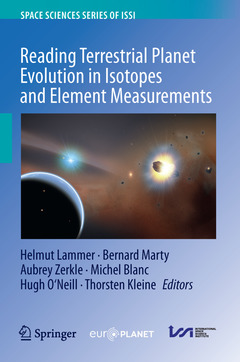Description
Reading Terrestrial Planet Evolution in Isotopes and Element Measurements, 1st ed. 2021
Space Sciences Series of ISSI Series, Vol. 80
Coordinators: Lammer Helmut, Marty Bernard, Zerkle Aubrey, Blanc Michel, O'Neill Hugh, Kleine Thorsten
Language: English
Subjects for Reading Terrestrial Planet Evolution in Isotopes and...:
Keywords
planetary building blocks; planetary interiors research; planetary atmospheres research; accretion timescale; planetary volatile delivery; Origin of the Moon; evolution of terrestrial planets; planetary plate tectonics; solar system chemical evolution; solar system isotopic evolution; planetary nitrogen atmospheres; solar system elemental evolution; solar system formation
Publication date: 06-2022
445 p. · 15.5x23.5 cm · Paperback
Publication date: 06-2021
445 p. · 15.5x23.5 cm · Hardback
Description
/li>Contents
/li>Biography
/li>Comment
/li>
Preface to Reading Terrestrial Planet Evolution in Isotopes and Element Measurements (Only in the ISSI book) H. Lammer, B. Marty, A. L. Zerkle, M. Scherf, H. O’Neill, M. Blanc, T. Kleine
1. The Sun through time M. Güdel
2. Chemical and isotopic evolution of the early Solar System K. R. Bermingham, E. Füri, K. Lodders, B. Marty
3. Formation of Venus, Earth and Mars: Constrained by isotopes H. Lammer, Ramon Brasser, A. Johansen, M. Scherf, M. Leitzinger
4. Geochemical constraints on the origin of the Moon and preservation of ancient heterogeneities S. J. Lock, K. R. Bermingham, R. Pari, M. Boyed
5. On the distribution and variation of radioactive heat producing elements within meteorites, the Earth, and planets C. O'Neill, H. O'Neill, A. M. Jellinek
6. Loss and fractionation of noble gas isotopes and moderately volatile elements from planetary embryos and early Venus, Earth and Mars H. Lammer, M. Scherf, H. Kurokawa, Y. Uneo, C. Burger, T. Meindl, C. P. Johnstone, M. Leitzinger, M. Benedikt, L. Fossati, K. G. Kislyakova, B. Marty, G. Avice, B. Fegley, P. Odert
7. Nitrogen atmospheres of the icy bodies in the solar system M. Scherf, H. Lammer, N. V. Erkaev, K. E. Mandt, S. Thaller, B. Marty
8. Perspectives on atmospheric evolution from Xe and nitrogen isotopes on Earth, Mars and Venus G. Avice, B. Marty
9. Mission to Planet Earth: the first billion years E. Stüeken, S. M. Som, M. Claire, S. Rugheimer, M. Scherf, L. Sproß, N. Tosi, Y. Ueno, H. Lammer
10. The isotopic imprint of life on an evolving planet M. K. Loyd, H. L. O. McClelland, G. Antler, A. S. Bradley, I. Halevy, C. K. Junium, S. D. Wankel, A. L. Zerkle
11. Future missions related to the determination of the elemental and isotopic composition of Earth, Moon and planets I. Dandouras, M. Blanc, L. Fossati, M. Gerasimov, E. W. Guenther, K. G. Kislyakova, H. Lammer, Y. L., B. Marty, C. Mazelle, S. Rugheimer, M. Scherf, C. Sotin, L. Sproß, S. Tachibana, P. Wurz, M. Yamauchi
Supplement Information
SI 1: Earth's Nitrogen and Carbon Cycles R. Halama and G. Bebout
SI 2: Relative atomic Solar System abundances, mass fractions, and atomic masses of the elements and their isotopes, composition of the solar photosphere, and compositions of the major chondritic meteorite groups K. Lodders
An interdisciplinary volume on terrestrial planetary atmospheres
Useful for academic and professional audiences across geoscience, biology and astrophysics
Discusses how future exoplanet atmospheric discoveries might change our understanding of our own Solar System planets




